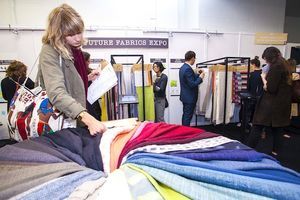
Sustainable cotton initiative displays its work at this year’s Future Fabcris Expo
For the first time, the Aid by Trade Foundation will present its Cotton made in Africa initiative during the Future Fabrics Expo that takes place from September, 28th until September, 30th in London. In an interview with Charlotte Turner, researcher and project manager of the Sustainable Angle, you can learn more about the fair and the underlying organization, the Sustainable Angle.
1. What is the aim of the Sustainable Angle?
The Sustainable Angle is a not for profit organization which initiates and supports projects which contribute to minimizing the environmental impact of industry and society, and that help make it easier for companies to make informed decisions when it comes to sustainability. We do this through projects including the Future Fabrics Expo, which focuses on how fashion’s environmental impact can be lowered through textile innovation, and novel ideas to transform the fashion system and design practice.
2. When has it been created?
The Sustainable Angle was set up in 2010 by Nina Marenzi, as while researching for her dissertation ‘Organic Cotton: Reasons Why the Fashion Industry is Dragging its Heels’ for her MSc in Sustainable Agriculture and Rural Development, she interviewed numerous fashion designers, representatives of the textiles industry, and NGOs. As a result, the need for a curated sustainable textiles showcase became apparent and the Future Fabrics Expo was born.
3. Who stands behind the Sustainable Angle?
The Sustainable Angle’s core team includes founder and director Nina Marenzi, researcher and project manager Charlotte Turner, and curator and educational consultant Amanda Johnston. The team has diverse experience in the sustainable energy and agriculture sectors, fashion design and production, education, and of course textiles.
4. What will be presented at this year’s expo in London? What will be the highlight of this year’s event?
This year we are planning to show hundreds of globally sourced fashion fabrics, trims, and components with a reduced environmental impact, along with in depth but easy to understand background information on sustainability and textiles, and short films introducing new companies and innovations. The Future Fabrics Virtual Expo is a new online tool to make the expo content available any time, from anywhere. In addition, we will be presenting a seminar exploring the future of fashion fabrics, and how as an industry we can become more sustainable.
5. Why has CmiA been chosen as partner of the Sustainable Angle and will be present at the Expo in London?
We will be showcasing Cotton Made in Africa as it is a viable sourcing option, highlighting the importance of responsible cotton cultivation to livelihoods and local economies across Sub Saharan Africa where CmiA is active. Additionally, we feel Africa is an emerging market for sourcing low impact cotton and textiles which benefit workers and communities, and we want to make it easier for designers and buyers to actually see, feel, and experience these textiles which they otherwise might not be able to. An essential element of the Future Fabrics Expo is the fact that we can show a curated range of globally sourced sustainable textiles in one place, which would otherwise be time consuming and difficult to source — this is a perfect opportunity to be able to connect designers and buyers with African textiles.
6. Has sustainable fashion already reached a broader market?
We are absolutely seeing an increased commitment to lowering the impact of textiles and the fashion supply chain overall in the UK fashion market, as well as abroad. Mainstream brands like H&M and M&S started introducing lower impact textiles to their ranges some time ago, also highlighting the issues surrounding the afterlife of clothing. We’re seeing cross industry collaborations, for instance the Pharrell Williams and G-Star Denim ‘Raw for the Oceans’ project, and brands including Burberry, Levi’s, Adidas and United Colours of Benetton have signed the Roadmap to ZDHC, aiming for zero discharge of hazardous chemicals by 2020. There is a very long way to go, but brands from across market levels and countries are beginning to see it is imperative that the industry makes real changes to stop the degradation and depletion of our natural resources.
7. What is the impact of the Sustainable Angle and the Future Fabrics Expo on the sustainable fashion branch? What has been your greatest success so far?
The Future Fabrics Expo has achieved a winning combination of increasing the visibility of innovative textiles, and promoting and communicating textiles with a reduced environmental impact to designers, buyers, press and global organizations, in a setting that is designed and curated to introduce textiles for the future with a lower environmental impact in a jargon-free manner. It has been recognized as an essential platform to learn more about the efforts of global textile mills to design, manufacture, and function more sustainably; to discover new fashion textiles and innovations for the future, and to extend networks in the fashion and textile industries. We have also received a large amount of positive press, with publications including Guardian Sustainable Business, Drapers, WGSN, EcoTextile News, Textile View, Sportswear International, The Fashion Spot, and TimeOut featuring the Future Fabrics Expo, which shows the widespread interest in making the industry more sustainable.
8. What are your future plans for the Sustainable Angle and the Expo?
We plan to continue reaching key players in the fashion and textiles industry, to showcase and promote solutions to reduce the environmental impact of industry and consumers, and to highlight that we can reduce negative environmental and social impact whilst maintaining and even increasing the quality, desirability, and functionality of products and services. We’ll be doing this through the Future Fabrics Expo, and also through the recently launched Future Fabrics Virtual Expo, to which we plan to add a fabric sourcing pool to allow visitors to purchase fabrics in collective orders to overcome the problem of large minimum order numbers.